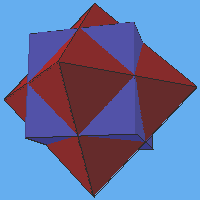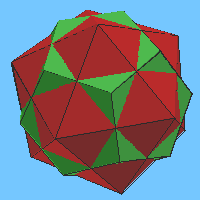Duality
For every polyhedron there exists a dual polyhedron. Starting with any regular polyhedron, the dual can be constructed in the following manner: (1) Place a point in the center of each face of the original polyhedron; (2) Connect each new point with the new points of its neighboring faces; (3) Erase the original polyhedron.
For example, starting with a cube, we (1) create six points in the centers of the six faces, (2) connect each new point to its four neighbors, creating 12 edges, and (3) erase the cube to find the result is an octahedron, consisting of eight triangular faces. So the dual of the cube, {4, 3}, is the octahedron {3, 4}.
 This
is an operation "of order 2" meaning that taking the dual of
the dual of x gives back the original x. For example, take
the dual of the octahedron and see that it is a cube. Note that when taking
the dual, a face with n sides transforms into a vertex where n faces meet,
and vice versa. The six 4-sided faces of the cube transform into the six
corners of the octahedron, with 4 faces meeting at each. The eight 3-sided
faces of the octahedron transform into the eight corners of the cube with
3 faces meeting at each. Also observe that the total number of edges remains
unchanged, as each original edge crosses exactly one new edge. The cube
and octahedron each have twelve edges. All these properties can be easily
seen if one makes a model of the cube
and octahedron together. The relative sizes of the two dual polyhedra
can be adjusted as shown here, so that their edges are the same distance
from their common center, and so cross through each other.
This
is an operation "of order 2" meaning that taking the dual of
the dual of x gives back the original x. For example, take
the dual of the octahedron and see that it is a cube. Note that when taking
the dual, a face with n sides transforms into a vertex where n faces meet,
and vice versa. The six 4-sided faces of the cube transform into the six
corners of the octahedron, with 4 faces meeting at each. The eight 3-sided
faces of the octahedron transform into the eight corners of the cube with
3 faces meeting at each. Also observe that the total number of edges remains
unchanged, as each original edge crosses exactly one new edge. The cube
and octahedron each have twelve edges. All these properties can be easily
seen if one makes a model of the cube
and octahedron together. The relative sizes of the two dual polyhedra
can be adjusted as shown here, so that their edges are the same distance
from their common center, and so cross through each other.
 Next,
observe how the dual of the icosahedron,
{3, 5}, is the dodecahedron, {5, 3},
and vice versa. The twenty 3-sided faces and twelve 5-way corners of the
icosahedron correspond to the twenty 3-way corners and twelve 5-sided faces
of the dodecahedron. Each has thirty edges. Here is the compound
of the icosahedron and dodecahedron which shows these relationships
very clearly.
Next,
observe how the dual of the icosahedron,
{3, 5}, is the dodecahedron, {5, 3},
and vice versa. The twenty 3-sided faces and twelve 5-way corners of the
icosahedron correspond to the twenty 3-way corners and twelve 5-sided faces
of the dodecahedron. Each has thirty edges. Here is the compound
of the icosahedron and dodecahedron which shows these relationships
very clearly.
The dual to the tetrahedron, {3, 3},
is another tetrahedron, {3, 3}, facing in the opposite directions.
Combining the two mutually dual tetrahedra into a compound
results in a solid which Kepler called the stella
octangula.
The above are all Platonic solids, so their duality is a form of Platonic relationship. The Kepler-Poinsot polyhedra also come in dual pairs. Here is the compound of great stellated dodecahedron, {5/2, 3}, and its dual, the great icosahedron, {3, 5/2}. Similarly, the small stellated dodecahedron, {5/2, 5}, and its dual, the great dodecahedron, {5, 5/2}, can be combined into this compound. But all you see from the outside is the former; you have to go inside it to see the latter.
All the above polyhedra are regular polyhedra, which have the special property that their duals are also regular polyhedra. In fact, the dual to {p, q} is always {q, p}. When one takes the duals of the Archimedean solids however, one gets a new class of solids, the Archimedean duals. The duals of the prisms and antiprisms are the dipyramids and trapezohedra.
In all these cases you might observe that the polyhedron and its dual have the same axes of symmetry.
Another way to graphically display duality is with transpolyhedra.
Virtual Polyhedra, (c) 1996,George W. Hart